
When Frank and Monica Woll bought two tiny islands in the Florida Keys in 2016 for their semi-retirement, they considered themselves privileged caretakers rather than owners. The day they arrived on Molasses Keys, twin islands encircled by the turquoise-blue waters of the Florida Straits, a dolphin swam beside their boat. Already resident were scores of pelicans, cormorants, egrets, herons and numerous other species of birds in a plethora of mangrove trees.
Then came the hurricanes: Irma in 2017, and Ian last year. Today the trees, and the birds, are mostly gone. The storms, combined with rising sea levels, have stripped about one-fifth of the islands’ land mass.

Frank and Monica Woll sit on a branch that used to be over firm ground
What happened to the Wolls in their little piece of paradise in the Florida Keys, an ecologically fragile island chain off the state’s southern tip, exemplifies the wider climate emergency facing the region.
What is The Rising Ocean series?
ShowIt started slowly but is surely picking up speed: the ocean, long considered so big it couldn't be affected by humanity, is creeping toward us. As the water warms and the ice sheets melt, sea level has risen more than half a foot in the last century – and even if we stopped producing greenhouse gases today, a very unlikely scenario, it will only keep coming. With 40% of the Earth's population living in coastal zones, the UN has warned that the accelerating pace of sea level rise threatens a "mass exodus".
What we do now matters. While stopping carbon emissions is the most important collective task, individuals around the world are fighting back against the rising waters in their own ingenious ways. As our islands vanish, our shorelines shrink and our cities flood, Guardian Seascape is telling the troubling but inspiring stories of how humanity is facing down The Rising Ocean.
Chris Michael, editor
Global heating has made Atlantic cyclones more frequent and powerful; rising seas are slowly submerging the Keys; and efforts to mitigate, from restoring mangrove forests to building barriers and raising roadways, are to many analysts merely delaying the inevitable.
But the Wolls, like many who live and work on the frontline of the encroaching ocean, are fighting back as best they can.
Instead of a life lolling in hammocks, kayaking, fishing and birdwatching, the couple, both in their early 60s, have embarked on a back-breaking programme of restoration.
They haul rocks, lumber and dead tree trunks into retaining walls. They plant hundreds of new mangrove saplings to replace those swept away in the storms.
Having sold their established kayak and paddleboard rental business to fund their purchase of Molasses Keys, they have little money to spare. But their project is entirely self-funded.
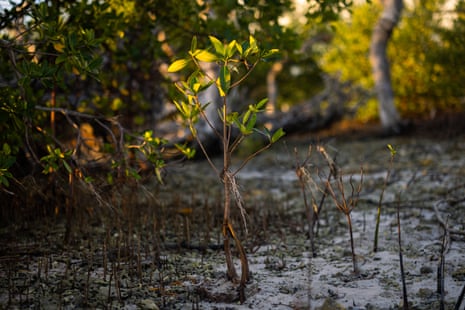
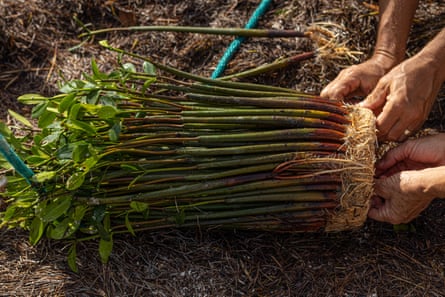
(Top) Mangrove saplings planted; (above) trying to pry loose the starters
“It’s hard to find a place to hang a hammock now anyway,” Frank Woll said, lamenting the loss of about 70% of their large trees, and the washing away of close to 20% of their total acreage.
The mangrove-planting project began last August with about 300 new plants along the eroded shoreline of the couple’s “big island” (where their houseboat is moored and where a sizeable tent, they hope, will ultimately be a base for their planned ecotourism business). However, so far it has not delivered the hoped-for results.
Only about one in five of the plants have survived. The rest died or were swept away in the water. A second wave of planting in February met with similar results.
Frank has yet to figure out why – he thinks it might be because the nursery plants were raised in freshwater and were shocked by the salinity of seawater – but he isn’t giving up.
“We don’t want to be out here building walls, we’d rather have it all natural. But what are you going to do? We have to protect things from getting washed away,” he says.
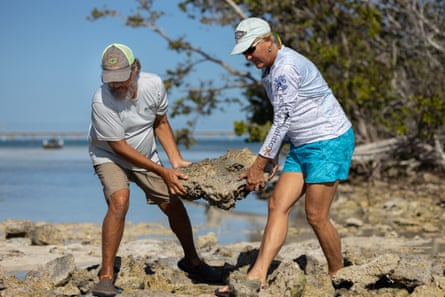
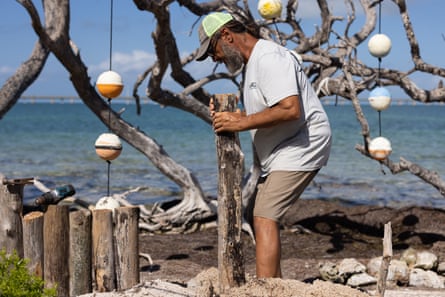
The couple build a retaining wall on the smaller of their two islands
“If there are no more major hurricanes for a while, the islands can find its course for its new lines, its new territory. But I don’t think it’ll ever grow again. It’ll slowly shrink. We can see that.”
As a lifelong outdoorsman who has lived in the Keys for more than 35 years, he knows that nature is cyclical.
“We enjoy watching the changes: nature trying to do its thing, even the birds and the critters. After Irma we were amazed to see anything on this island, but the hermit crabs survived. The island is still alive,” he said.
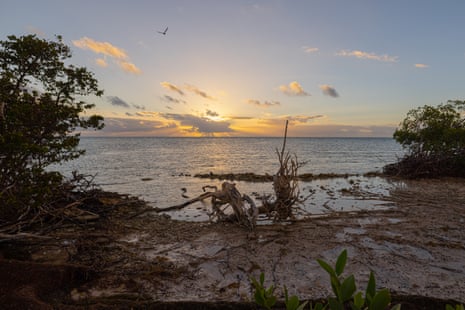
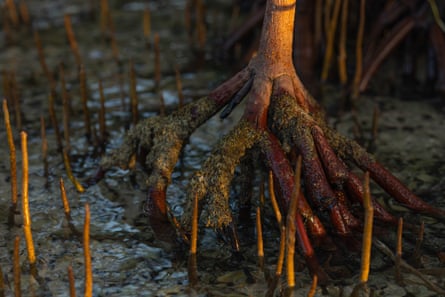
(Top) the retaining wall in place; (above) black mangrove roots turn up above the water to capture air
“But the sad thing is the trees. Before Irma it was a forest. We have before-and-after Google Earth pictures: it was so lush you couldn’t see anything, full vegetation, all grown mangroves, not young stuff. Then you look at the picture from after Irma: there’s no trees – it’s just rock and sand, all beat up. You could see right across the island.”
With 90% of the Keys at an elevation of 5ft (1.5 metres) or less, the outlook for rising seas is dire. The cost of losing the precious red mangroves, in particular, is even higher than the destruction of a birding habitat or the erosion of shoreline.
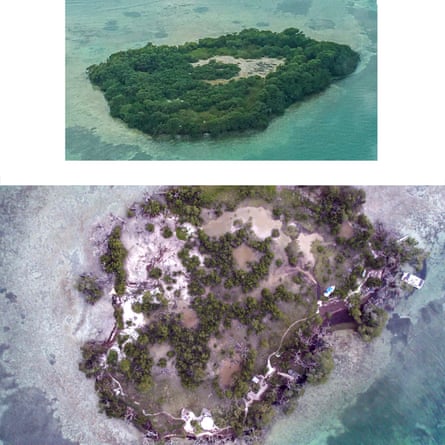
(Top) Molasses Keys in 2017, before Hurricane Irma struck; (above) a more recent shot showing the loss of vegetation
Decomposing mangroves leaves are an important food source for shrimp, crab and fish; an estimated 75% of game fish and 90% of commercial species in south Florida are dependent on the mangrove system during at least part of their life cycles, according to the University of Florida. Mangroves also absorb significant quantities of carbon dioxide, helping to counter the effects of global heating.
It’s why Florida lawmakers are attempting to beef up existing legislation dealing with mangrove protection, and why macroscale mangrove restoration initiatives are in place to achieve what the Wolls are trying to replicate individually.
“Low survival rates are not unusual,” said Laura Flynn, the president of Florida’s nonprofit Coastal Resources Group, who has decades of experience in mangrove restoration.
“If you plant too low in the water column, too far out in the water and they’re just in standing water all the time, the seedlings aren’t going to survive. And the ones that are planted too high are too dry. The sweet spot is the high water line. Mangroves like to be flooded during those high tides, but then they like the water to go away.”
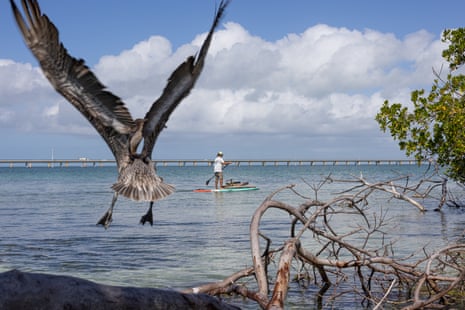
Frank paddleboards his logs and chainsaw to the other side of the island. In the background is the Seven Mile Bridge
Like the Wolls, Flynn believes the consequences make saving mangroves too important to give up on. “We keep fighting the battle to keep our shorelines healthy,” she said. “Mangroves provide nursery habitat for a lot of our commercial and recreational fisheries – and if one thing goes, it’s a chain reaction.”
Back on Molasses Keys, as Frank Woll helps his wife, formerly a park ranger, drop another chunk of their dock retaining wall into place, he contemplates their determination to preserve what he sees as the true value of the islands.
“The islands, we may own them, but the critters that live out here, it’s really their home, not ours. It’s not ours to mess about with,” he said. “We’re just the caretakers.”
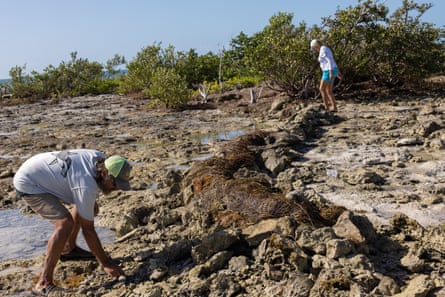
Work continues on the retaining wall



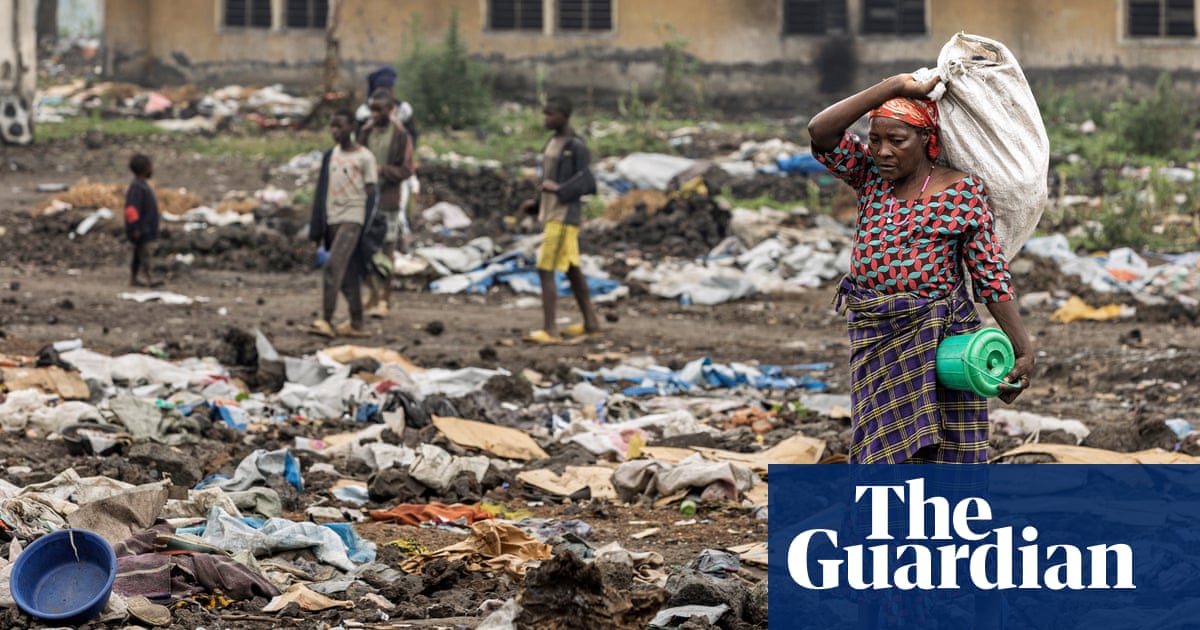






 English (US)
English (US)